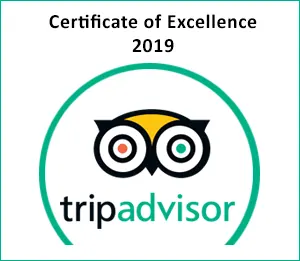Day 1: Arrive in Hanoi, Vietnam.
Arrival Details.Your arrival and departure transfers can be reserved with your guest relations manager, who is assigned to you after you book your tour. You will be met by an Easy Tours Travel Facilitator. You are then driven to your top-ranked boutique hotel and assisted with your check-in - available starting 3 PM. The Peridot Grand Hotel is located in the heart of the iconic Old Quarter, and offers a unique blend of artistic design and contemporary comfort. The small hotel’s beautiful décor, exceptional service, and comfortable, well-appointed rooms, combined with its enviable location near major attractions, great restaurants, cafes and bars, as well as the vibrant street scene, make for a great introduction to Hanoi.
The Best Tour of Vietnam and Cambodia
This is a Private Guided Vacation - You are the Only Guests
Start on Your Preferred Date, Subject to Availability
Upscale Lodging Shown, Upgrades Available to Luxury & Opulent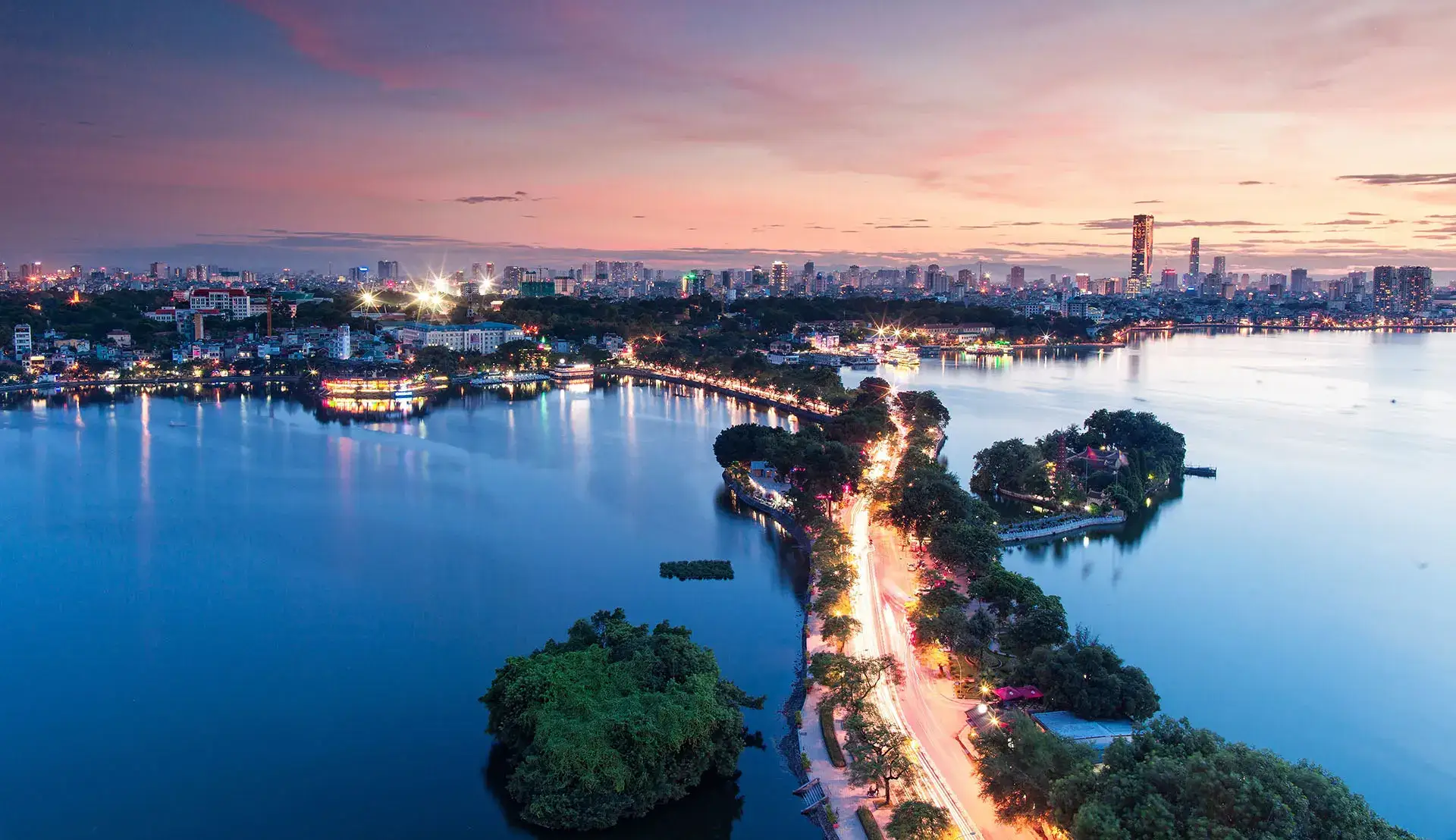
Sunset in Hanoi
Early Arrivals.We strongly recommend that our guests consider arriving a day earlier, as this allows you to recuperate from jetlag, and serves as insurance against international flight delays and cancellations. An additional night’s lodging can be added as part of the process as you reserve your tour. If you are arriving a day earlier, your private airport to hotel transfer will be provided a day earlier.
About Hanoi’s Old Quarter. Hanoi is one of the world’s most fascinating cities to explore on foot, with an exceptionally vibrant street food scene, and its Old Quarter is always abuzz with activity and has an amazing energy that is near impossible to resist. Located on the banks of the Red River, Vietnam's capital retains a unique old-world charm and has some of Asia’s most striking colonial architecture.
(Overnight – Peridot Grand Hotel)
Day 2: Hanoi. (Breakfast)
Temple of Literature. Start your exploration of Vietnam’s capital with a visit to the Temple of Literature. Built in 1070 as a Confucian temple and school, this complex became Vietnam’s first university six years later. Multiple courtyards, water tanks, temples, and unique architecture are what you will notice first. A unique sight here is 82 large stone slabs (with large tortoise shaped bases of stone) that have the names and other details of doctoral laureates of the university from 1442 to 1779. It is common to see local students at the temple in school groups throughout the year, and large bunches of kids are here dressed in their finest during graduation periods. Walk around the complex and its gardens and explore several temples housing beautiful statues of the university’s founders and greatest scholars.
Ho Chi Minh Mausoleum. Next up is the impressive Ho Chi Minh Mausoleum complex. This site is highly revered by the North Vietnamese, and consists of several structures, including Uncle Ho’s (Ho Chi Minh) modest house on stilts, and of course the iconic mausoleum itself. This granite structure stands prominently above the parade area and grandstand at a height of 70 feet and is surrounded by meticulously maintained lawns and gardens. Please note that we do not recommend viewing the preserved body of Ho Chi Minh, housed inside, as this requires a 45 minute (minimum) wait in line, and no photos are allowed.
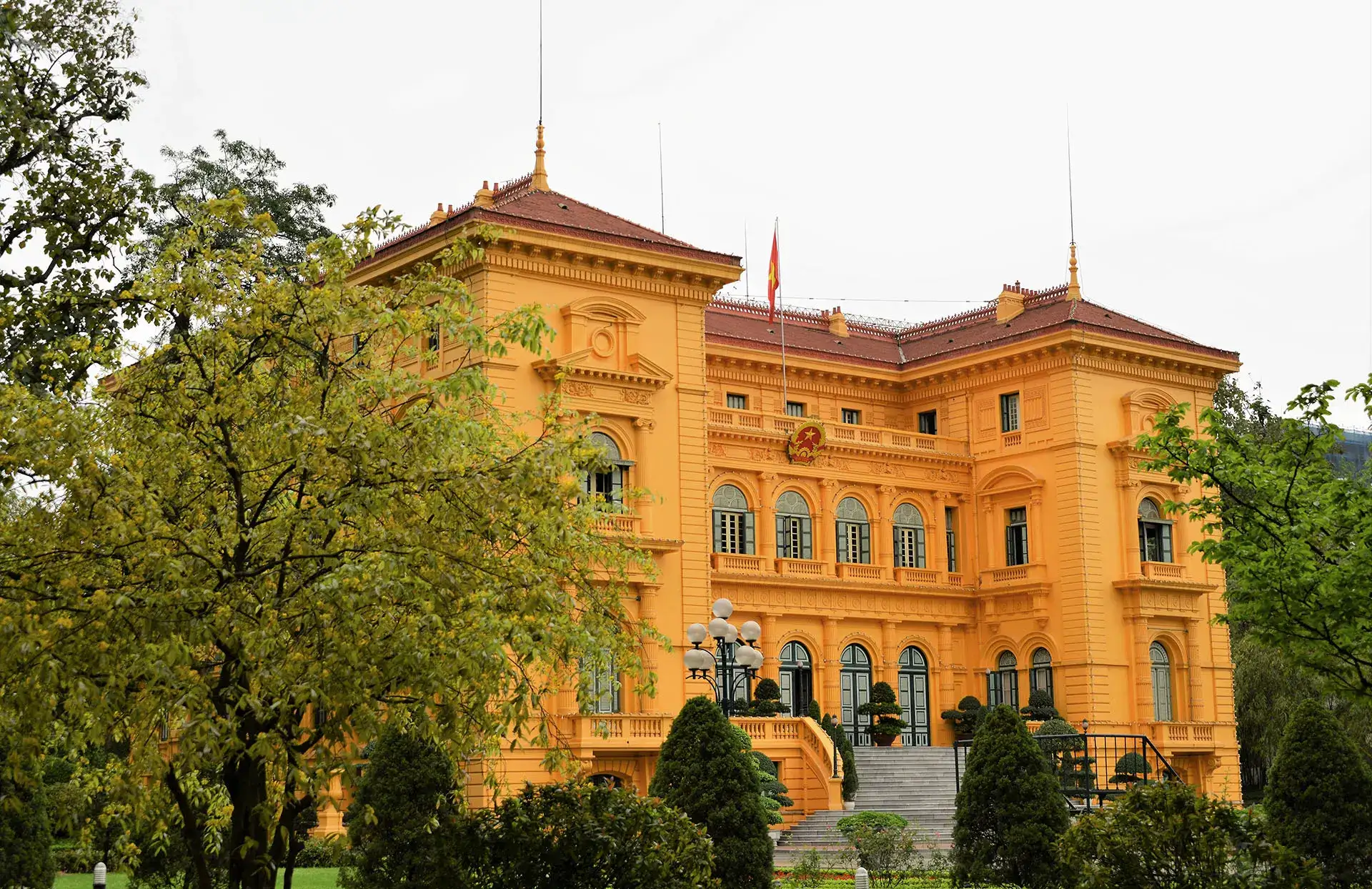
Presidential Palace Hanoi
Presidential Palace. Next to the mausoleum is the beautiful Presidential Palace, built between 1900 and 1906 as the French Governor General of Indochina’s residence. The Palace is not open to the public, but you can stop here for a photo opportunity of the front left profile of the structure, as well as its beautiful gardens. Ho Chi Minh refused to live in the palace and had a simple home on stilts built in the gardens, which you will walk through to admire its simplicity and austerity.
Old Quarter Walk. Return to the old quarter and break for lunch. After lunch you will experience a guided walk through the fascinating historic enclave. When Hanoi was much smaller, this area was the residential, commercial, and manufacturing hub. Each street was dedicated to locals practicing a particular trade, and this practice has continued until today, except the fact that there are far more street food outlets and cafes, adding even more color to an already fascinating sight. Your Guide will walk you through streets such as Hand Dong Street (copper wares street) Hang Tre Street (bamboo wares street), and so on. Many of the streets still have temples, pagodas, and communal structures from old times.
(Overnight – Peridot Grand Hotel)
Day 3: Hanoi. (Breakfast)
Museum of Ethnology. You'll be driven to West Hanoi to visit the Museum of Ethnology, a remarkable institution dedicated to the diverse ethnic cultures of Vietnam. This unique museum features expansive indoor and outdoor spaces, curated to offer a comprehensive exploration of the country's cultural tapestry. Inside, you'll find an extensive collection of artifacts, including traditional clothing, tools, musical instruments, and household items, each telling the story of the various ethnic groups that call Vietnam home. The outdoor area showcases full-scale replicas of traditional dwellings, including stilt houses and communal halls, providing an immersive experience into the architectural styles and living conditions of these communities.
Citadel of Thang Long (UWHS). Explore the Citadel and the historic colonial administration district. The Citadel of Thang Long, Hanoi's former name, offers a journey through 13 centuries of history. Already a UNESCO World Heritage Site, in 2002 an extensive excavation unveiled relics and cultural layers that you will also enjoy today. Begin at the iconic Flagpole, proceed through the central Kinh Thien Palace, and continue to the Revolutionary House D67, which served as the meeting room for the Politburo and Central Military Commission during the resistance against the US.
Hanoi’s Most Beautiful Avenue. The small urban lake is also known as The Lake of the Restored Sword, and the area surrounding it is Hanoi’s cultural center. Visit Ngoc Son Temple, situated on a small island in the photogenic lake, and observe the fascinating rituals that take place here - the devout visit it throughout the day. There is a break for lunch, after which you will return to your lodging and you are at leisure to enjoy the Old Quarter and your hotel for the next couple of hours.
Water Puppetry. In the early evening comes a fascinating performance of Water Puppetry, where Easy Tours guests will enjoy preferred seating. The Thang Long Puppet Theatre is Hanoi’s most famous because of the quality of the performers, and it is located on the banks of Hoan Kiem Lake, across from Ngoc Son Temple. This art form, which is unique to North Vietnam, originated in the 11th century. The combination of indigenous music, small fireworks, and the colorful wooden performers, as well as the accomplished musicians visible in the gallery, makes this spectacle a great introduction to North Vietnamese culture.
Old Quarter Night Walk. After the performance, you will enjoy a short walk to your hotel by the charming lake, walking past the locals as they dine on street food, an activity that is omnipresent at night all over the Old Quarter. By now you will start realizing that the Vietnamese take street food to a whole new level, even by Southeast Asia standards – people eating are everywhere, occupying sections of the pedestrian walkways, parks, sometimes taking over parts of the roads after sunset, enjoying the wares of scores of small street stalls.
(Overnight – Peridot Grand Hotel)
Day 4: Hanoi – HaLong Bay. (Breakfast, Lunch and Dinner)
Drive to Ha Long - Start Cruise. Check-out from your hotel in the morning, and then you are driven to an island off the coast of Ha Long. Upon your arrival you will join your fellow cruise travelers in a reception area where refreshments will be served. After a while you will be assisted in boarding your top-ranked luxury vessel. This is one of the newer cruisers on the bay and you will be in a beautiful balcony cabin on the upper deck with wonderful views.
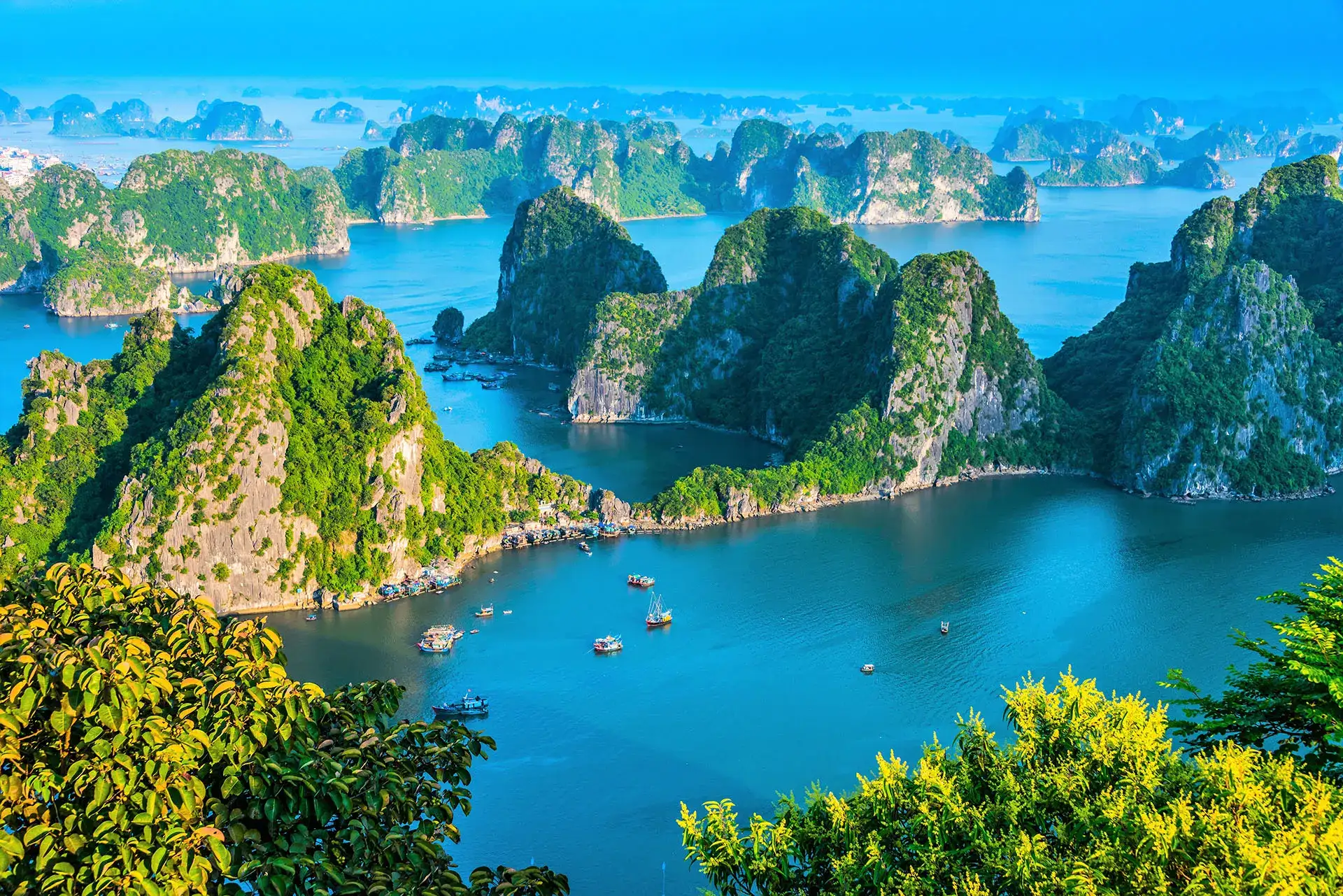
Halong Bay Arial View
HaLong Bay. The entire bay on this coast of Vietnam is one of the world’s most spectacular seascapes, resulting in it being listed on the UNESCO World Heritage List. The water is very calm on the bay, and the scenic beauty is characterized by a vast area that is full of lush limestone (karst) hills jutting out of the ocean. Your cruise will cover parts of Ha Long Bay and Lan Ha Bay and you will visit some of the main attractions, but you will also spend quite a bit of time where most other cruises don’t go, in stunning locations that are a little off the beaten track.
Excursions and Activities. You will have various excursions available during your cruise, including options to kayak, swim, visit floating villages, and a lot more, and there will also be a full schedule of activities on the ship that you can participate in. Excellent Vietnamese and western cuisine options will be served throughout your cruise. Lunch is served shortly after the cruise begins.
(Overnight – Paradise Grand Cruise)
Day 5: Ha Long Bay – Hue. (Breakfast and Brunch)
Cruise, Excursion, & Disembark. Wake up a little early to stunning views and then enjoy breakfast, after which you have the option to experience this morning’s scheduled excursion. Return after the scheduled morning excursion (if you choose to participate), and a full brunch will be waiting for you. The boat now begins its leisurely cruise to the dock, giving you plenty of time for more relaxation and photography. Check out of your cabin and you are met by your Guide and chauffeur at the dock.
Flight to Hue. You are then driven to Hanoi airport to board your flight to Hue, The City of Mist. From Hue Airport you are driven to your art deco historic riverfront resort for check-in. By far Hue’s best lodging option, it was the residence of the French Resident Superieure (Governor) in times past. Time Magazine listed this hotel in its best hotels in the world in 2019, and the resort has received countless other awards. We use the larger Deluxe Rooms as the standard Superior Rooms are a little small.
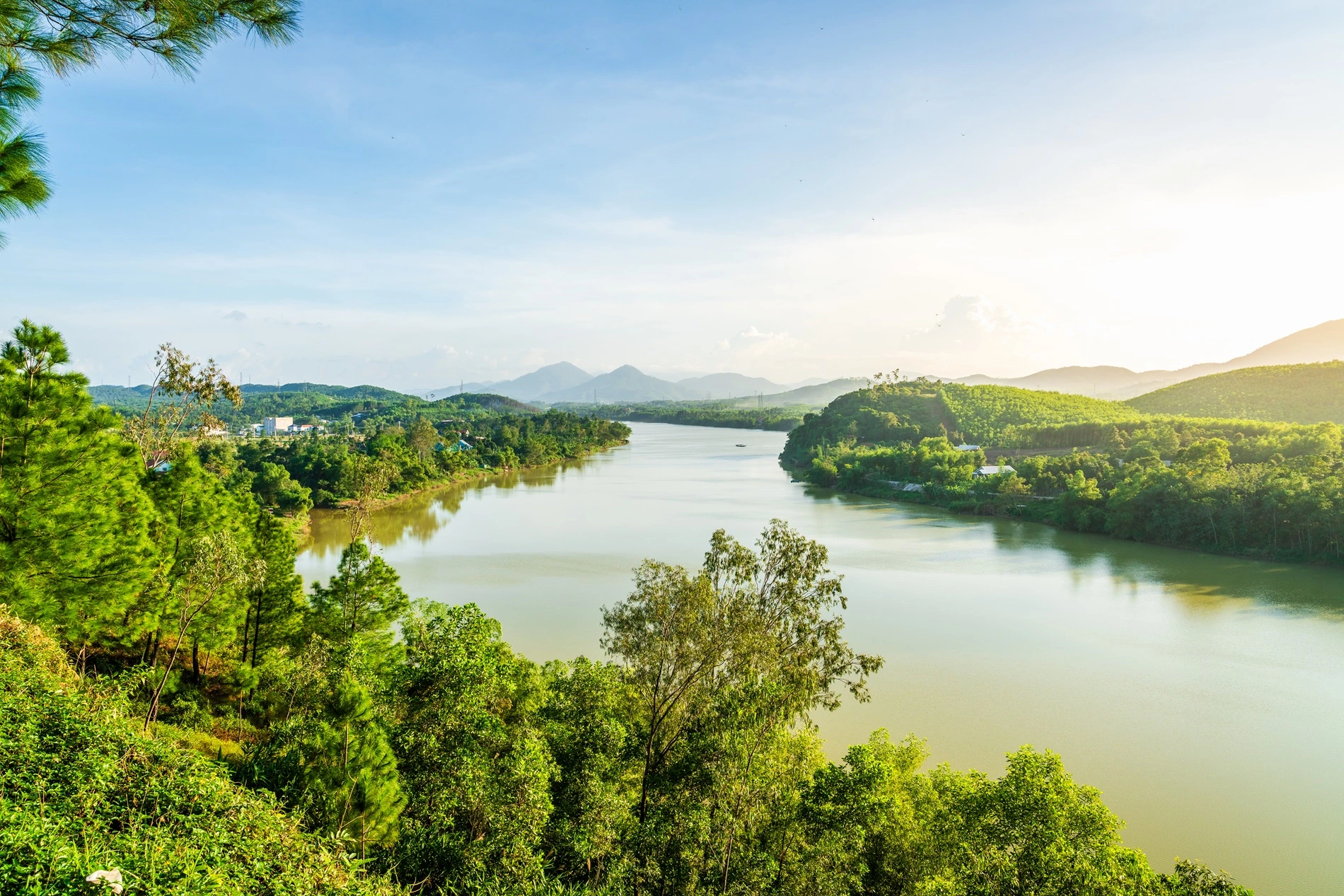
Perfume River
The City of Mist. Hue is known for its magnificent monuments built under the Nguyen Dynasty (1802 - 1945), and also famous for its amazing food, as well as its unique conical hats. Unlike Hanoi and Saigon, the city has a relaxed vibe, and evening walks by the Perfume River, and the delightful cafes that are found here, are highly recommended. The monuments that you will visit here make up one of Vietnam’s eight UNESCO World Heritage Sites. This honor was bestowed on the city in 1993 since it is such a fine example of an eastern feudal capital.
(Overnight – Azerai La Residence)
Day 6: Hue.
Royal Mausoleums. Your day will start in the morning with a visit to the impressive mausoleum of King Tu Duc (ruled 1848 - 1883). Close by is the next attraction, the unique mausoleum of King Khai Dinh (ruled 1916 - 1925). These ornate and colorful monuments, designed by the kings themselves, were also used as holiday retreats during their lifetimes.
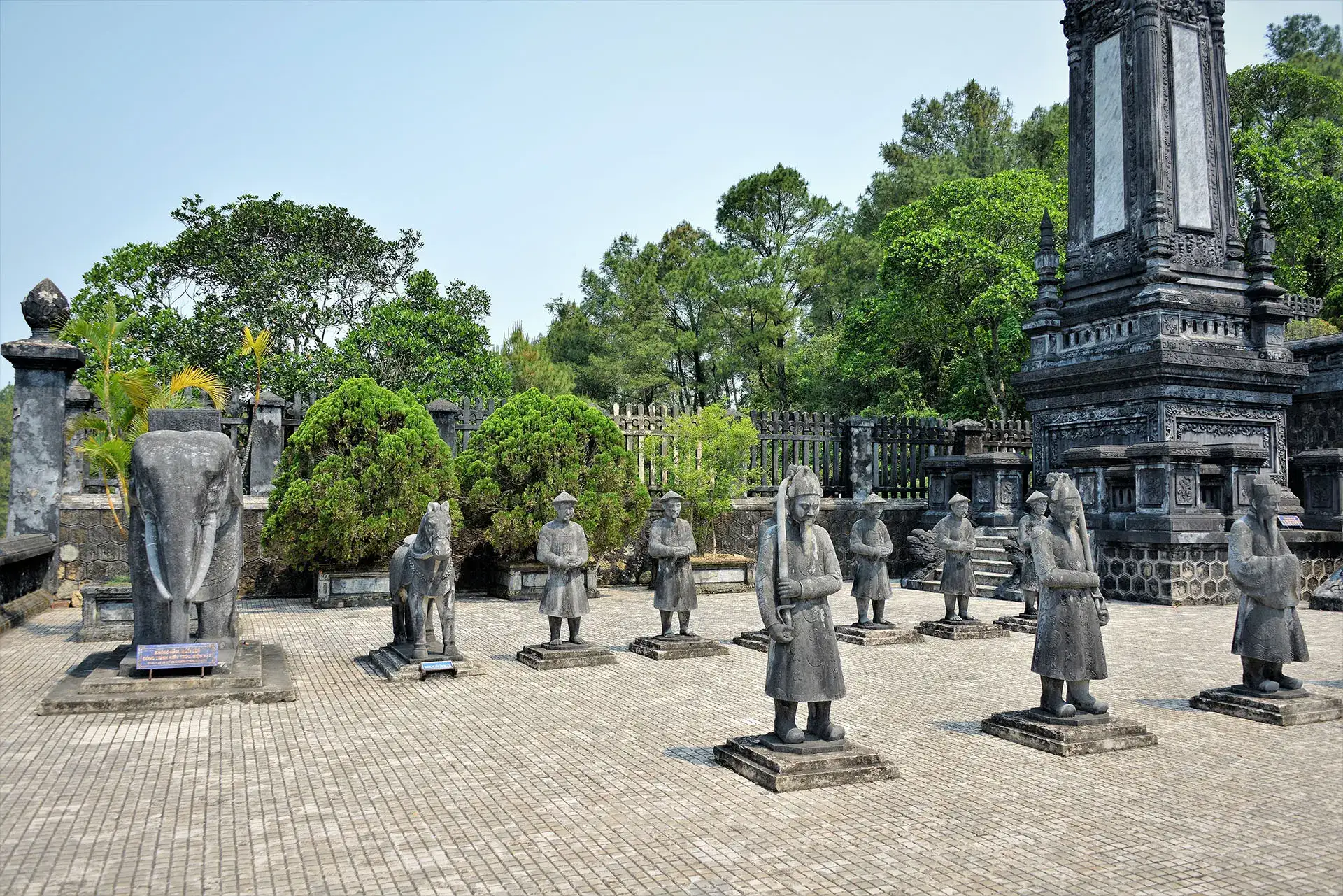
A Courtyard at King Tu Duc's Mausoleum
Old Town Walk. Next you will enjoy a guided walk-through older part of Hue, including a busy market located next to the river. The market is teeming with local vendors selling a variety of goods, from fresh produce to handmade crafts. The air is filled with the aroma of exotic spices and the sounds of lively bargaining. People are bustling about, some buying, some selling, and some just enjoying the lively atmosphere. There are also local artisans displaying their crafts, including the traditional Hue hats. The river provides a serene backdrop to this lively scene, with small boats gliding gently along the water.
Hue Citadel. After a lunch break you will continue your exploration with a visit to the Royal Citadel, a UNESCO World Heritage Site. The sprawling complex of palaces, fortifications and pagodas was, in its day, virtually impenetrable. It is enclosed by a massive square fortress with over 13-foot-tall walls and a wide moat fed by the Perfume River. The site was selected based on geomancy principles, with natural features like Ngu Binh Mountain and the Perfume River providing protection and auspicious omens. The layout reflects a blend of the Five Cardinal Points and elements of ancient oriental philosophy.
Imperial City. The Imperial City in the citadel includes structures such as the Thai Hoa Palace, which was used for official ceremonies, and the Can Thanh Palace. The Imperial City also contains various temples, residences, and administrative buildings, showcasing traditional Vietnamese architecture influenced by Chinese styles.
Purple City. The Forbidden Purple City is the innermost section and was reserved for the emperor and his close confidants. It featured the emperor's residence and many essential royal structures. Much of this area was heavily damaged during the Vietnam War but is undergoing restoration.
(Overnight – Azerai La Residence)
Day 7: Hue – Hoi An. (Breakfast)
Scenic Drive to Hoi An. Embark on a scenic 3.5-hour (approximately) drive to Hoi An. Some of this drive is through coastal fishing villages, and much of it is on one of Southeast Asia’s most spectacular roads, where you straddle the Pacific Ocean with amazing views on one side, and lush green hills on the other. At the highest point of the journey, you will have a breathtaking view of the Pacific, and on the other side a view of the modern city of Da Nang and its bay. You will drive through the outskirts of Da Nang as you head towards Hoi An, and a brief photo opportunity stop will be at the beach zone that was a favorite for American soldiers during the Vietnam war, immortalized in the television series China Beach.
Inland to Hoi An. Arrive near historic and charming Hoi An in the early afternoon, and we recommend a slightly late lunch at a very nice beachfront restaurant. After lunch, you will be driven inland for about 15 minutes and assisted with your check-in at your top-ranked boutique resort. Although the Heritage town of Hoi An is an ancient seaport, it is now about 3 miles from the coastline as the crow flies. Easy Tours uses the highest rated and top-ranked lodging in Hoi An, and the boutique lodge is located within Hoi An and is a very short walk or drive from the UNESCO Site.
Location and Comfort. You will be staying in a beautiful Verandah Suite in the more exclusive Club Section of the lodge, and the services and cuisine are among the best you will experience anywhere in Southeast Asia. A leisurely 10-to-15-minute walk, 3-minute taxi ride, or a 5-minute bike ride (complimentary at your resort) can bring you to the ancient town in case you want to return there at any time during your stay. Although the food at your lodge is excellent, we also recommend the extremely charming French inspired riverfront restaurants and cafes in the ancient town for dinner this evening.
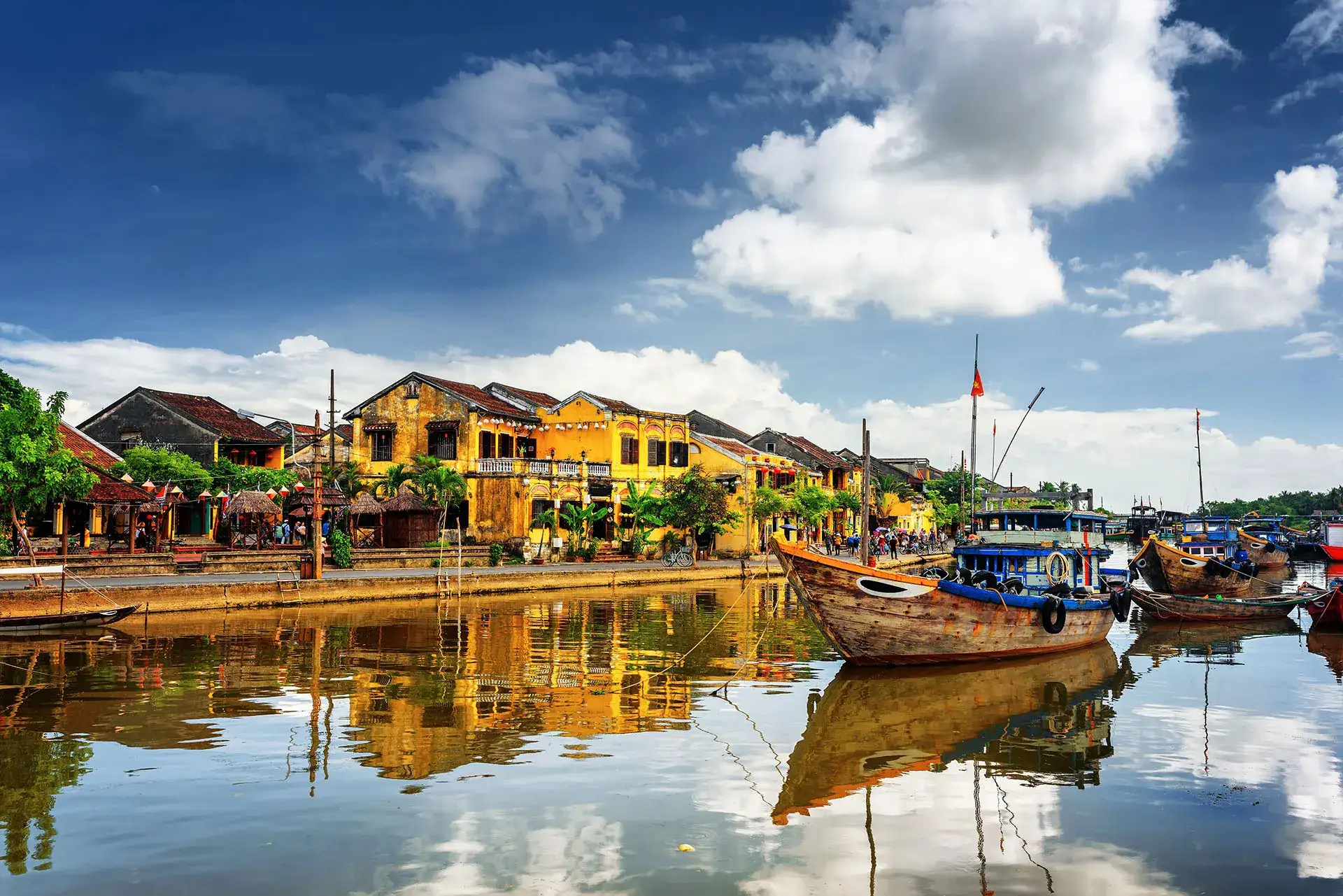
Hoi An
Hoi An (UWHS). Hoi An is classified as a UNESCO World Heritage Site as the best-preserved ancient seaport in Southeast Asia. Easy Tours prefers not to take our guests to the ancient town during the late morning and early afternoon as, during those hours, it gets really crowded and noisy due to a large influx of tourist bus groups from the large Da Nang casino resorts. We begin your discovery of the ancient seaport in the late afternoon with a guided walk through the Japanese and Chinese Quarters of the tiny ancient town. One of the highlights is the beautifully crafted and much-photographed Japanese Bridge. You will also visit a number of temples, pagodas, communal houses, traditional shops, and other places of interest in the small town.
Evening in Hoi An. You can either head back to your resort in the early evening, or, continue experiencing the ancient town this evening and have dinner at one of the delightful cafes and restaurants located on the river – the better restaurants have a distinctly French ambiance.
(Overnight – La Siesta Resort & Spa)
Day 8: Hoi An. (Breakfast)
My Son Sanctuary Excursion. Excursion. Join your Guide for an excursion to the UNESCO World Heritage Site of My Son Sanctuary. These remarkable structures lie about an hour away from Hoi An, and the structures go back as far as the 4th Century. It is one of the most important examples of Hindu influence in Southeast Asia. Although largely in a state of ruin today, My Son is often compared with other historical temple complexes in Southeast Asia, such as Angkor Wat of Cambodia or Ayutthaya of Thailand.
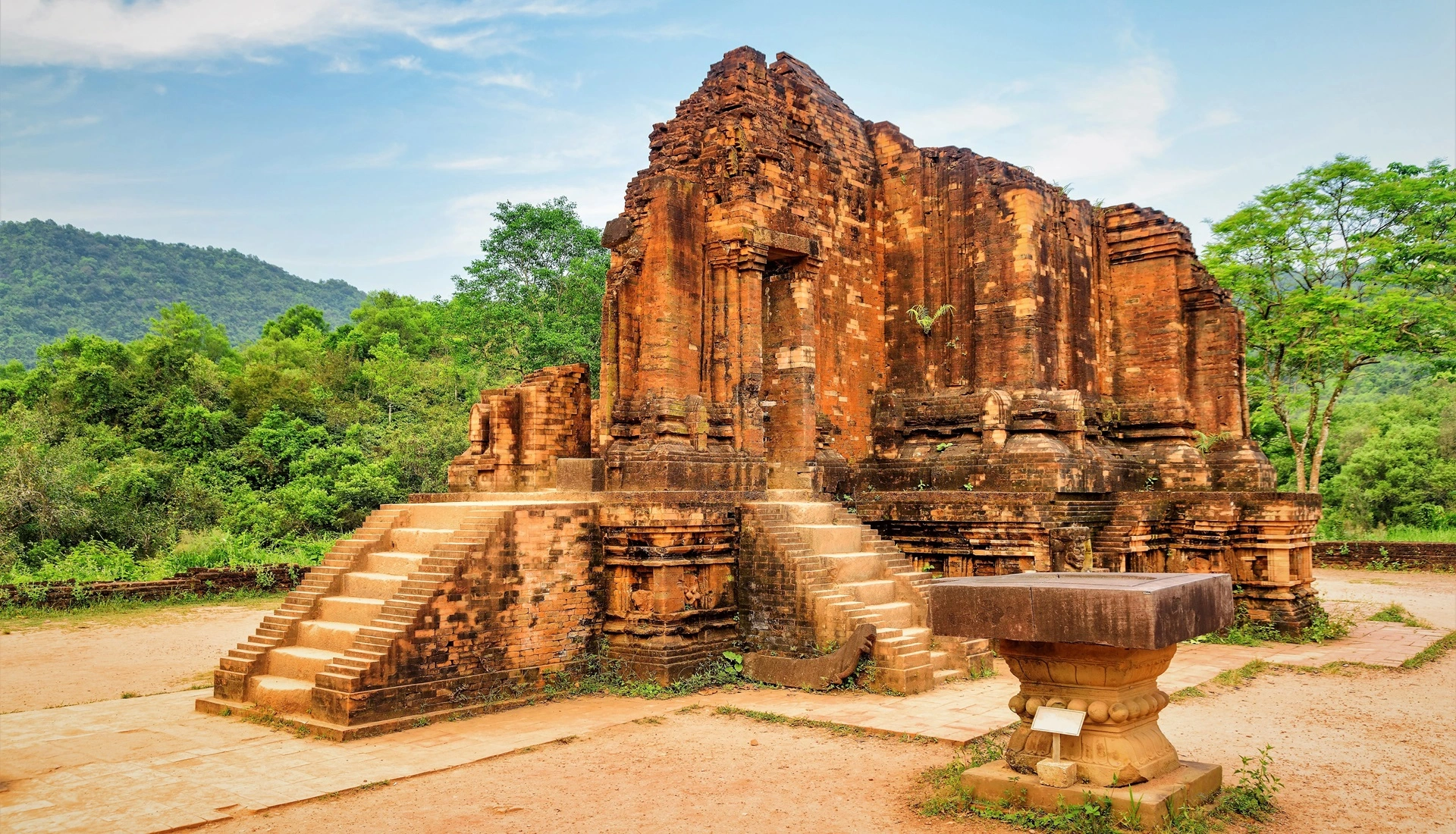
My Son
Champa Kingdom. After an introduction of Cham history and culture (and its Hindu influence) during your drive, you will arrive at the ancient site. My Son served as the capital of the Champa Kingdom and the site contains over 70 temples and structures built from the 4th to the 14th century. These temples were constructed using fired brick and stone, showcasing sophisticated Cham engineering and artistry. The temples are adorned with intricate sandstone bas-reliefs depicting scenes from Hindu mythology and Cham history. The temples are noted for their unique construction technique, which involves using a plant-based resin as mortar, making the structures remarkably durable and weather-resistant.
Return to Hoi An and break for a late lunch in the wonderful ancient town of Hoi An. After lunch you are driven to your nearby resort for leisure until the evening entertainment. Guests who want to explore more of the ancient town can choose to return on their own during the afternoon.
Hoi An Memories Show. A little after 7 PM you are escorted to the ancient city for a wonderful outdoor cultural performance, held on an island on the Thu Bon River. You have upgraded seating at the show which covers 400 years of Hoi An's history through five distinct acts performed by over 500 actors. It takes place on a 270,000 square foot stage designed to resemble the ancient town of Hoi An, complete with elaborate sets, merchant ships, and even a rolling elephant. Visitors are taken on a journey through time, witnessing Hoi An's transformation from a rural village to a vibrant trading port. The narrative is driven by the visual and emotional impact of the performances rather than dialogue, making it accessible to all audiences.
(Overnight – La Siesta Resort & Spa)
Day 9: Hoi An – Da Nang – Saigon. (Breakfast)
Fly to Saigon. Check-out of your resort in the morning and you are driven to Da Nang airport, crossing the charming Dragon Bridge on the way. You are assisted in boarding the noon flight to Saigon. Upon arrival at Saigon Airport, you are driven to Cu Chi, located in the countryside north of Saigon.
Cu Chi Tunnels. This area is famed for its elaborate network of over 200 kilometers of three-story underground tunnels hand-dug by local people during the Vietnam War. You have the option to experience climbing down into a tunnel and crawling around to get a taste of how the North Vietnamese soldiers (Viet Cong) lived during the latter part of the war. There are displays of weaponry that was used, as well as life-sized mud likenesses of the North Vietnamese soldiers depicting the lives they lived.
District 1. After this experience you are driven to Saigon where you are assisted with check-in at Vietnam’s most luxurious city hotel, the Reverie. You are in the heart of Saigon’s downtown (District 1), and restaurants, bars, and shopping are right at your doorstep, as are historical structures such as the Opera House.
Saigon. You are a couple of minutes’ away from the scenic Saigon River. Dinner and/or a drink is recommended at the Saigon Saigon Rooftop Bar at the nearby (5-minute walk) upscale Caravelle Hotel – this is the spot where American correspondents such as Dan Rather, Tom Brokaw and Peter Jennings received their daily war briefing and it was their favorite watering hole during that time. Both the food and the drinks are very good.
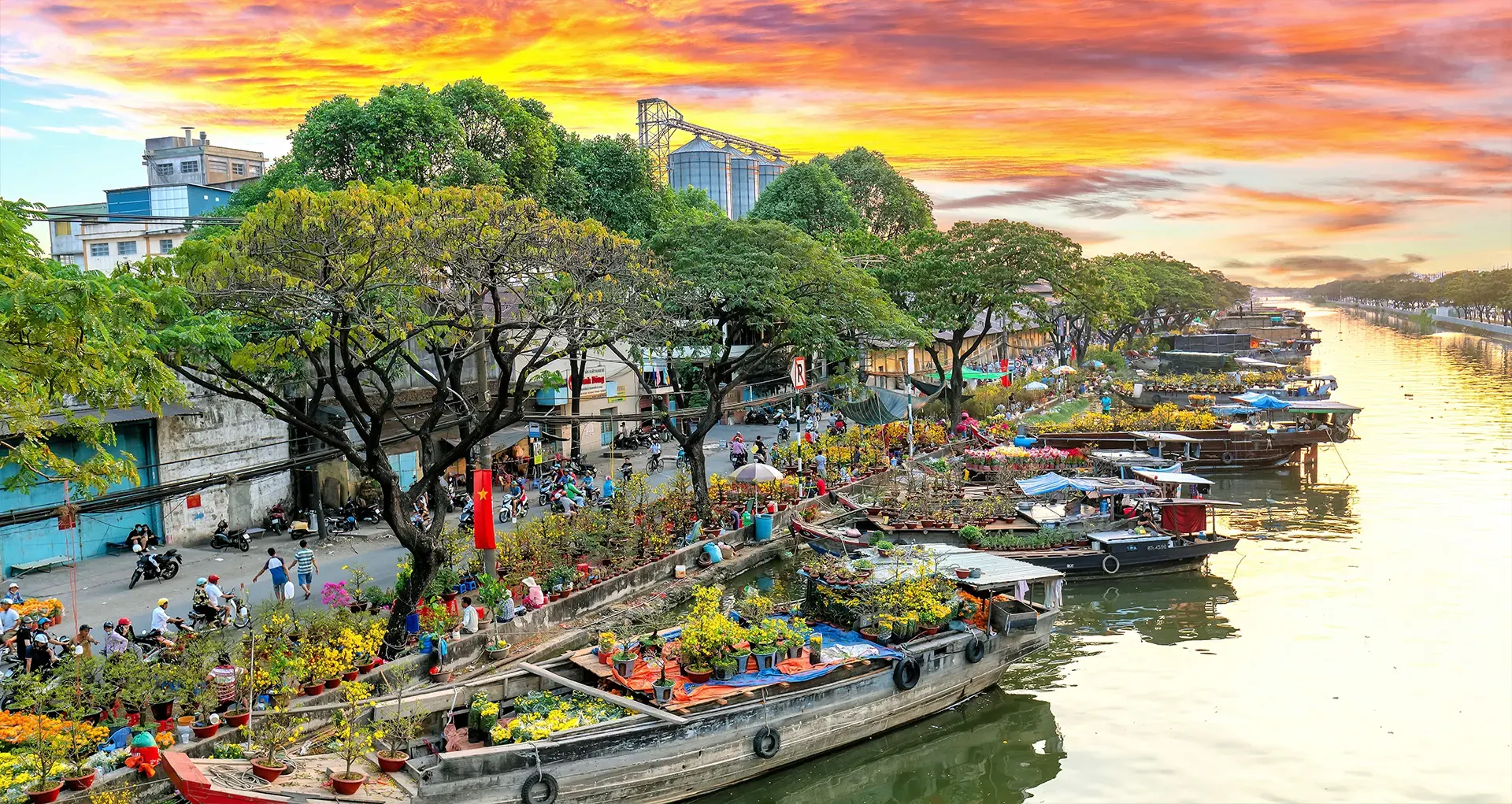
Nursery on Canal
Ho Chi Minh City. Located near the mouth of the Mekong, this city was once nothing more than swampland inhabited by a few Khmer people. Today it is Vietnam’s largest and most metropolitan city, with its official name, but most everyone still calls it Saigon. The city of over 9 million people is a prototypical large Asian city with an impressive modern skyline overlooking busy streets overflowing with, for western visitors, chaotic scooter, motorcycle and other traffic.
(Overnight – Lotte Hotel Saigon)
Day 10: Saigon. (Breakfast)
Reunification Palace. You will start your day in the morning with a visit to the Reunification Palace. This was the headquarters of the United States supported South Vietnamese government and has been left largely as it appeared on the day the Viet Cong’s tanks crashed through the gate and claimed victory for the North. The original furniture, equipment rooms, and war rooms remain untouched, all the way down to the rotary phones on the desks and strategic maps on the walls.
Travel Back Half a Century. In the middle of the crowded city, this large structure and its vast grounds are a fascinating time warp taking you back to the early 1970’s. Next, enjoy a visit to the beautiful colonial building housing the Central Post Office, with its amazing collection of century old western telegraphs and other machines. This is an active place of business, and the gorgeous antique interior includes wooden phone booths and counters that the locals will be standing at while buying services.
Central Post Office. After lunch you will enjoy a walk-through Saigon, including the famous shopping street of Dong Khoi. Your guided walk will begin at the Saigon Central Post Office, a stunning example of colonial architecture with its ornate facade and grand interior. This post office is not just a place for mail services; it's a historical landmark, showcasing French colonial influences and featuring a large portrait of Ho Chi Minh.
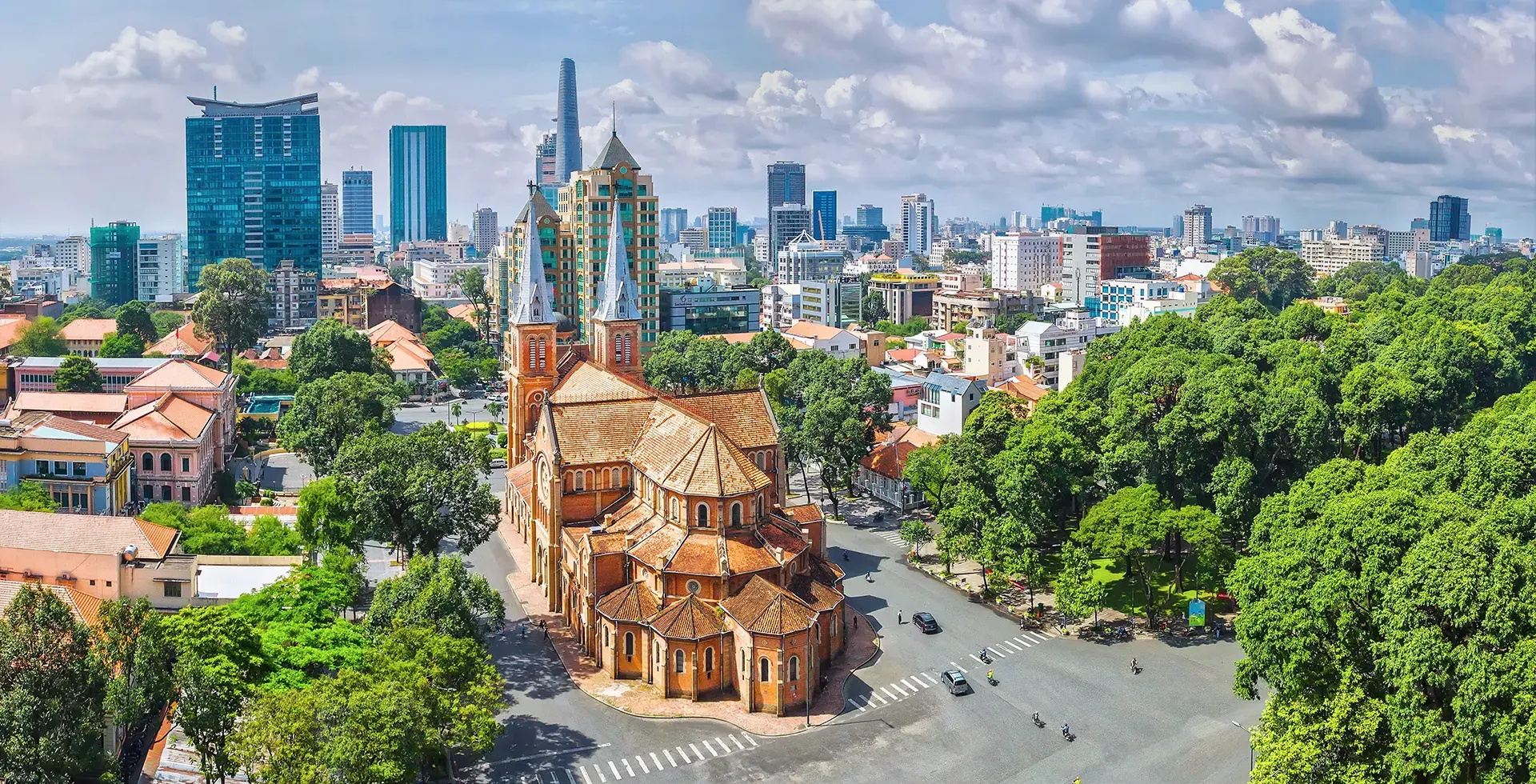
Notre Dame Cathedral
Notre Dame Cathedral. From the post office, you'll stroll next door to Notre Dame Cathedral, another architectural marvel. This Romanesque cathedral, with its twin bell towers and red brick facade, is a serene oasis amidst the bustling city. It's a revered place for local worshippers but is currently under multi-year renovation and entry is not permitted.
Dong Khoi Street. A leisurely walk leads you down Dong Khoi Street, a vibrant and bustling thoroughfare in the heart of Saigon. This street is a mix of old and new, with luxury shops, charming boutiques, and historic sites. Along Dong Khoi Street, you'd experience the dynamic pulse of the city, with the blend of colonial-era buildings and modern establishments. This street has a lively atmosphere and is a great place to absorb the local culture. Throughout the walk, you'd witness the blending of historic and modern elements, showcasing Saigon's rich history and its rapid development. It's a journey that offers insights into the city's past and present, making it an unforgettable experience.
(Overnight – Lotte Hotel Saigon)
Day 11: Saigon - Siem Reap, Cambodia.(Breakfast)
War Remnants Museum. You are assisted with your check-out in the morning and a short drive will bring you to the War Remnants Museum. We do not recommend this museum to guests who may find gruesome war atrocities photos, descriptions, and exhibits. Also, please bear in mind that the atrocities exhibited are those attributed to American soldiers, during what Vietnam calls the American War. For those that want to forego the museum, you can enjoy your spectacular hotel until the mid-morning or explore surrounding District 1 with your guide.
Ten Thousand Buddha Temple. In the mid-morning you will be driven to this unique Temple in District 5 of Saigon. Although Vietnam is not a Buddhist nation, this unique temple draws locals for prayer and tourism. The temple features beautifully carved wooden altars, granite staircases, and detailed reliefs that depict various Buddhist tales and figures. The decorations include golden gilt carvings and vibrant paintings of Guanyin and other deities. The central attraction on the fourth floor is a large Buddha statue surrounded by 10,000 smaller Buddha statues creating a mesmerizing visual experience for visitors. This main hall is a sight to behold with its intricate decorations and serene atmosphere.
Fly to Siem Reap. After lunch you are driven to the airport and assisted with your check-in for your flight to Siem Reap, Cambodia. Arrive in Siem Reap and you are driven to your top-ranked boutique upscale hotel and assisted with your check-in. The Shinta Mani Angkor is a boutique upscale property with a blend of contemporary style and traditional Khmer elements, set within lush gardens in the heart of Siem Reap's French Quarter. Conveniently located within walking distance of Pub Street, the Old Market, and other attractions, the hotel has exceptional service, beautiful design, and a tranquil environment.
(Overnight – Shinta Mani Angkor)
Day 12: Siem Reap. (Breakfast)
Angkor Wat Sunrise. Rising before dawn, proceed for your exploration of the most famous temple in Southeast Asia, Angkor Wat. Believed to be the world's largest religious building, this 12th century temple is a perfect fusion of symbolism and symmetry and a source of pride and strength to all Khmers. Arrive at the monuments entrance before the sun rises and walk to a location near the temple, where your sunrise view of Angkor Wat is across lotus ponds. This is the best time to visit Angkor Wat because it is the least crowded during the early morning, and watching the sunrise over the awe-inspiring complex is an experience not to be missed. After admiring the sunrise, you will proceed into the massive complex to discover its incredible structures and plethora of intricacies, which will be highlighted by your Guide.
After exploring Angkor Wat, you are driven back to your resort for to have breakfast and some time to freshen up.
Angkor National Museum Curated Tour. In the late morning you will enjoy a curated tour of the Angkor National Museum. This visit and your time with the curator will enhance your understanding and experience in the Angkor Region. The museum currently houses a vast collection of priceless Angkorian artefacts and art, among other things. There are 8 Galleries, each dealing with a specific Khmer Period, including two that are devoted to Angkor Wat and Angkor Thom that you will visit.
Angkor Thom. After a break for lunch, you will explore the immense walled city of Angkor Thom and its multiple awe-inspiring monuments built at a scale that is simply amazing. Following the occupation of Angkor by the Chams from 1177 to 1181, the king decided to build an impregnable fortress at the heart of his empire. The causeway is lined by an intricate bridge depicting the Churning of the Ocean of Milk from Hindu mythology in which the Devas (gods) and Asuras (devils) are engaged in tug of war with a Naga (seven-headed serpent) to obtain the elixir of immortality. Begin your visit at the Terrace of the Leper King. This intricately carved platform was the royal crematorium and the statue that was originally thought to be the leper king is now believed to be Yama, the god of death.
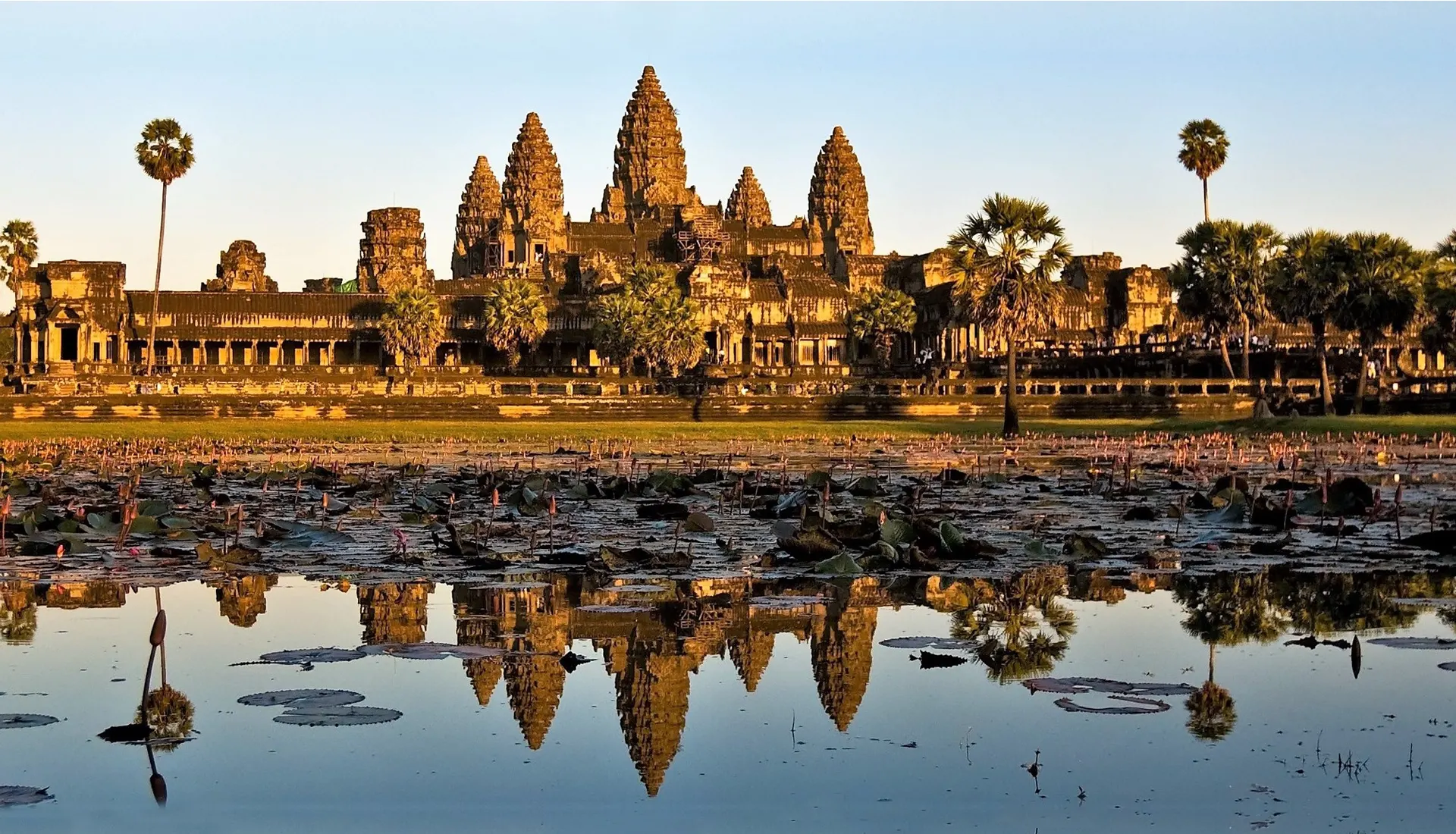
Angkor Wat
The Enigmatic Bayon Temple and More. You will continue along the Terrace of Elephants, originally used as a viewing gallery for the king to preside over parades, performances, and sporting events. At the southern end lies the Baphuon, once of the most beautiful temples at Angkor, dating from the 11th century. It has undergone a massive renovation by the French and is now once again open for viewing. Next up is the enigmatic and enchanting temple of the Bayon. At the exact center of Angkor Thom, this is an eccentric expression of the creative genius and inflated ego of Cambodia’s most celebrated king. Its 54 towers are each topped off with the four faces of Avalokiteshvara (Buddha of Compassion), all of which bear more than a passing resemblance to the king himself.
Ta Prohm and Preah Khan. A fitting end to your Angkor Thom exploration is the mystical Ta Prohm, which has been abandoned to the elements. Left as it was discovered by French explorer Henri Mouhout in 1860, the tentacle-like tree roots here are slowly strangling the surviving stones. This was one of the settings for the original Tomb Raider movie. Complete your exploration of this section of Angkor’s wealth of monuments with a visit to another temple that makes you feel like you have traveled back in time - Preah Khan. This large temple has also been left unrestored for the most part and is a fascinating maze of narrow passageways and windows that each offers their own unique view into the past.
Siem Reap Night Market – This evening, guests who want to experience Siem Reap’s most popular night market will join your Guide for a fascinating walk through the local night market to shop for all sorts of souvenirs and locally made apparel. This is a very large and colorful market with scores of stalls and haggling is expected.
(Overnight – Shinta Mani Angkor)
Day 13: Siem Reap.(Breakfast)
Banteay Srei.Join your Tour Director Guide at 8:30 AM for a very scenic 45 to 60-minute drive through the Cambodian countryside to Banteay Srei, which means the Citadel of the Women, or Citadel of Beauty. The name Banteay Srei probably comes from the unmatched details in the carvings of the voluptuous and beautiful Apsaras and Hindu Gods and Goddesses. Constructed from hard Red Sandstone, this small complex is a study in detail and the intricacy of its original sculptures is amazing to behold and is unsurpassed even among all the wonders found in the Angkor region.
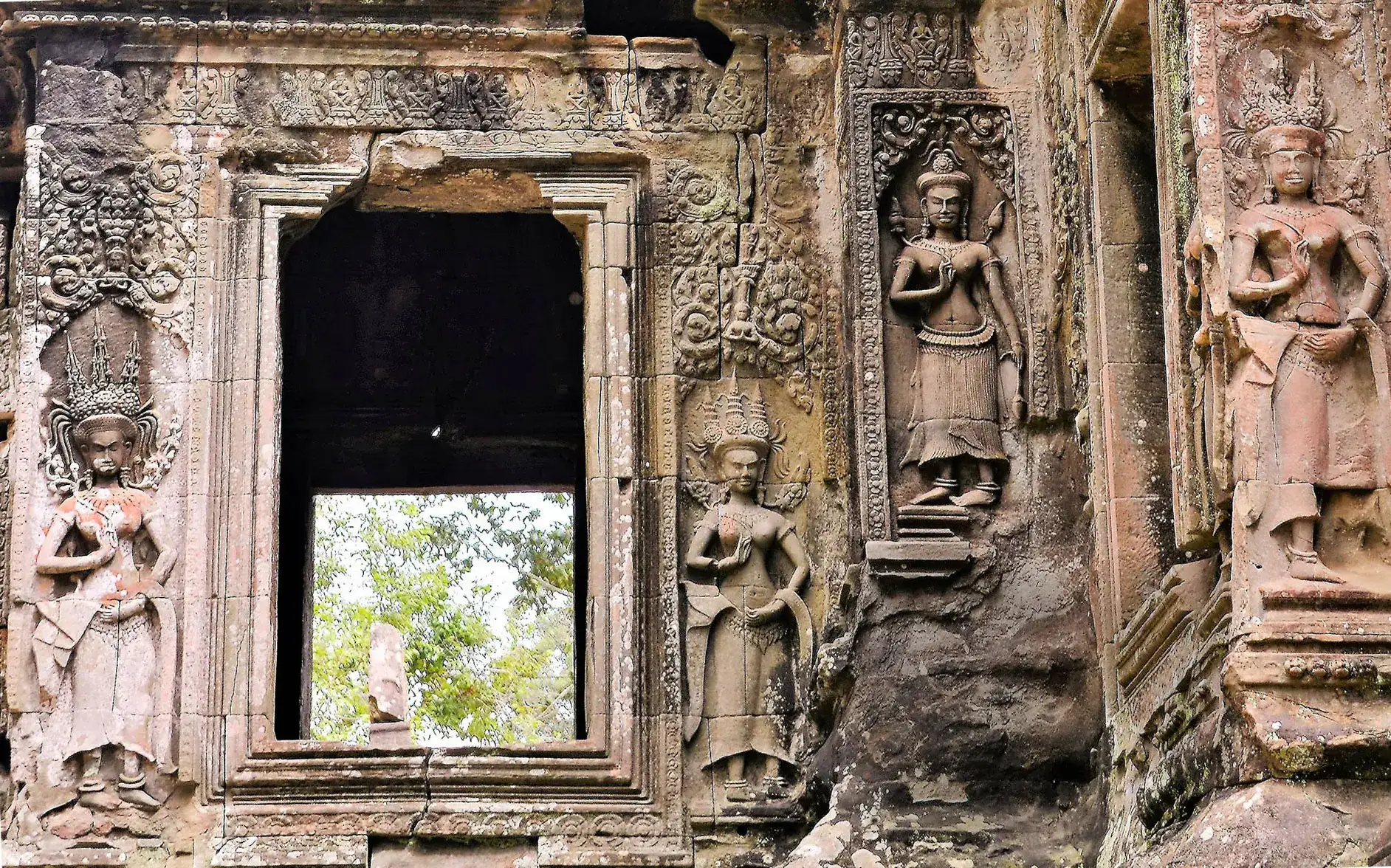
Apsara's at Banteay Srei
Citadel of the Women. The best time to visit Banteay Srei is in the morning when the sun lights up the red sandstone. Banteay Srei is also dedicated to the Hindu God Shiva, and, at more than a thousand years of age, it is older than almost all of the more significant temples in the Siem Reap Region. Some parts of this temple, more so than in other Angkor Region monuments, are replicas due to theft over the last few decades, before adequate protection was added.
Tonle Sap Lake UNESCO Biosphere Reserve. From Banteay Srei you will head towards Tonle Sap, stopping for lunch along the way. Tonle Sap is the largest freshwater lake in Southeast Asia, the lake is connected to a river of the same name. The area is one of the most biodiverse in the world, and its waters were what sustained the magnificent Angkor civilization, and others before that. The lake loses much of its water during winter, and when the rains come in the late spring/early summer, the lake fills up and rises over 30 feet.
Kampong Khleang. You will board your boat and explore the lakeside fishing community of Kampong Khleang, the largest town on the lake, and no doubt be impressed by the network of houses on up to 30-foot-tall stilts, lush farmlands, and small fishing communities. You will have the opportunity to observe how the locals live and work in this unique environment. Unlike the very touristy and hawker-filled village of Chong Kneas, where almost all other tours go, Kampong Khleang offers a more authentic experience.
(Overnight – Shinta Mani Angkor)
Day 14: Siem Reap – International Flight. (Breakfast)
Checkout and Flight. You are assisted with your checkout in the mid-morning and driven to Siem Reap Airport and assisted in checking-in for your international flight. Additional Services such as additional lodging, flights to major hubs, and/or transfers, can be arranged with your U.S. based Guest Care Specialist after tour reservation.
Our Services End at Siem Reap Airport.
Lodging
| City | Hotel | Room Type |
| Hanoi |
Peridot Grand Hotel
|
Junior Suite
|
| HaLong Bay |
Paradise Grand Cruise
|
Executive Grand Balcony Cabin
|
| Hue |
Azerai La Residence
|
Deluxe Room
|
| Hoi An |
La Siesta Resort
|
Verandah Suite Club Wing
|
| Saigon |
Lotte Hotel Saigon
|
Deluxe River View Room
|
| Siem Reap |
Shinta Mani Angkor
|
Bayon Room
|
Inclusions ▼
| The Best Local Guides at each destination |
| Breakfast daily except for Arrival Day |
| Ground transportation via upscale vehicles |
| Representative for assistance on departure / arrival transfers per the itinerary |
| Applicable monument entrance fees as per the itinerary |
| Bottled water during sightseeing |
| Hotel accommodation as listed above |
| All Boat Fees/Fares per the itinerary |
Exclusions ▼
| International travel except countries on your Easy Tours Journey |
| Any expenses of a personal nature, such as tips, laundry, phone calls, drinks etc. |
| Meals other than those specified on itinerary |
| Travel insurance, visas, etc. |
Our Lowest Pricing
| Lodging | Land Cost - Dbl Occupancy | On Tour Flights | Total Cost |
| Upscale (As Shown in Itinerary) |
$5,700 PP | $620* PP | $6,320 / per person |
| Luxury View Hotels |
$7,560 PP | $620* PP | $8,180 / per person |
| Opulent View Hotels |
$12,400 PP | $620* PP | $13,020 / per person |
Annual Sale. Aug 16th to Aug 30th
Save 10% On All Our Tours
Subject to Availability of our Preferred Guides & Lodging for Your Dates
Ask Questions Or Send Us Your Dates
Please wait while we are processing your request...




